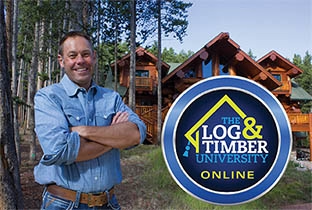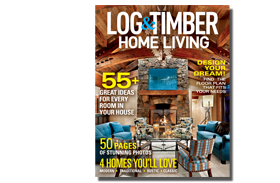In log and timber homes, when it comes to material selections, it may seem like sacrilege to spring for anything but the real deal. After all, you opted for a construction method that puts craftsmanship and nature front and center.
But today’s alternative materials are not the phony impersonators of yesteryear. Innovations in materials and manufacturing have delivered a selection of sustainable, stylish and, importantly, budget-minded solutions that are taking over showrooms. And when it comes to healthy choices, durability and savvy spending, that’s something we all can get behind. Here are five products that are (almost) better than bona fide.
A Substitute for Stone

According to the 2024 U.S. Houzz Kitchen Trends Study, engineered quartz has risen notably in popularity and was the most requested material for upgraded countertops over granite, quartzite, wood and marble. This synthetic material is made from crushed stone, resins and pigments and is both durable and attractive. It’s been on the market for more than half a century, but has made major improvements in its imitation of stone in recent years. Take for example Caesarstone’s OOAK line, which stands for “one of a kind” and celebrates “the unrepeatable nature of veining” with patterns that are, in fact, truly one of a kind.
Leather’s Lookalike

For a long time, leather alternatives came with one big downside — they were largely constituted of plastic. Today, a new world of plant-based leathers is changing that. MasayaCo, a sustainable furnishings manufacturer, shows just how flattering imitation can be with its Diria armchair, made with Forest Stewardship Council-certified teak wood and four shades of cactus leather.
Shake Things Up

Cedar shakes lend a coveted timeless style to exteriors. However, they’re also famously expensive and vulnerable to the same threats any wood product is — namely moisture and wood-boring insects. Ludowici offers a lightweight terra cotta shake as a low-maintenance alternative. The tiles boast pressed grooves, scratches and rugged butts to achieve the look of real wood. Plus, they’re fire-resistant.
LVP, the MVP of Flooring

Tough against scuffs, scratches and moisture — and with a cheaper price tag than wood — luxury vinyl plank (LVP) flooring has emerged as an increasingly popular flooring solution for high-traffic, heavy-duty applications. For some, the off-gassing of volatile organic compounds (VOC) is a fair concern, but brands like Proximity Mills boast lines with no- to low-VOC options.
Not Just for Dolls

It’s worth noting — vinyl doesn’t own the wood-look market. Porcelain, prized for its versatility, longevity and durability as well as its mold- and bacteria-resistant non-porous surface, can do quite the impression. Not just a flooring choice, designs like those in TileBar’s Scandi-inspired Nobu collection make a statement on vertical surfaces like backsplashes, fireplaces, shower walls and more.
See Also: Finish From the Bottom Up











